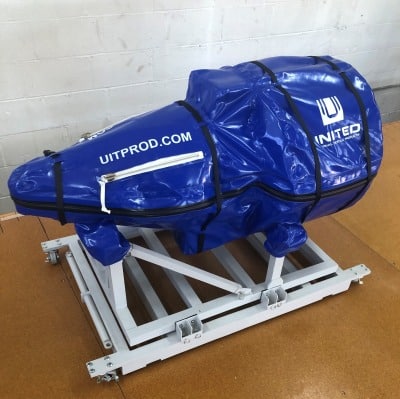The biggest problem we face when trying to solve a troublesome issue is where to start. You have an engine that you have taken in for repair or overhaul. You need to protect it while it is being worked on, and then you need to safely return it to your customer. Or perhaps you have a grounded engine that needs to be stored, but you aren’t sure what storage solution is right for both the equipment and your budget. United Industrial Textile Products has specialized in the aerospace industry for over four decades, and these are just some of the questions we have received from customers during that time. We’ve compiled a list of key factors to consider when choosing the right cover to fit your needs.
1. Identify the Function
The first question you need to answer is what is the cover’s purpose. While certain types of engine covers may look similar, they actually perform very different functions.
Shipping Covers are designed with durability in mind. At UITP, our shipping covers come in two layers. The first is a lightweight inner liner that acts as a dust cover, ideal for use while the engine is being worked on. When the engine is ready to leave your facility, the heavy duty outer cover is added. Made from durable 22 oz vinyl, this is specifically designed to put up with all the wear and tear that the road can dish out.
Long-Term Storage Covers create a stable environment for advanced and sensitive equipment. Ours are made from a vinyl with a very low vapor moisture transmission rate, and coupled with a special closure system designed to create a seal all the way around the engine. This serves one important purpose – to prevent damage due to humidity. The ideal long-term storage cover creates a contained and controlled environment for monitoring and regulating humidity levels through use of desiccant.
Complex pieces of machinery have many ports, inlets, outlets, turbine blades, and sensitive computer circuitry that need to be protected during the lengthy process of both building and maintenance of the equipment throughout its life cycle. F.O.D. Covers can secure one area of the equipment while another is being worked on. They can range in size from a jet engine fan case intake to a 3” diameter outlet.
Dust can be as harmful as metal shavings or impact damage when it comes to complex components. A Dust Cover is designed specifically for this issue. Ours are made from soft and lightweight microfiber and are ideal for quickly covering components during the initial build phases, as well as while performing maintenance and overhaul on your equipment.
2. Material and Technical Features
Using the right material for your project is crucial when it comes to getting the results that you require. Advanced knowledge of the different textiles available can help with choosing which one will fit your needs. At UITP, we work closely with our customers to determine what material will meet their unique needs. Low vapor moisture transmission rate is of no concern to someone looking for high durability and abrasion resistance. No reason to use something more expensive if it isn’t adding a value to your project. The right material option is out there, and we can help you find it.
The cover should be assembled in a way that will not create an area of vulnerability that would allow moisture or particles access to the equipment. To mitigate this risk, our covers are sealed together using both forced hot air and RF sealing methods, to ensure there are no stitches for moisture to find its way through the membrane.
Covers must be able to open and separate in order to engulf your equipment for ease of installation. This creates the problem of how to effectively seal the membrane back up. Our closure is a two-track seal system coupled with a closure tool specifically designed to create an airtight seal. Think of it as an oversized ziplock bag. A really durable one. We also utilize airtight zippers to allow easy access to our long-term storage covers for desiccant change out, maintenance, and monitoring checks.
3. Consider Desiccation and Humidity Control
Desiccation is key in preventing damage of specialty equipment due to humidity. As touched upon earlier, an effective long-term storage cover, when coupled with humidity indicators and proper levels of desiccant, can produce a controlled environment, ideal for storing engines for long periods of time.
Depending on where the engine is being stored, the levels of desiccation needed to regulate humidity levels will also change. High humidity areas around the equator will need more desiccant than the engine being kept in a dry desert environment. The good thing is that if you are not certain what is required in your given area, you can’t go wrong erring on the side of more desiccant. Your equipment is expensive, desiccant is cheap. This needs to be used in concert with active monitoring of your equipment and humidity indicators, be it electronic or reactive cards.
4. Storage of Cover When Not In Use
The price of sustaining an advanced piece of equipment for an extended period of time can be quite expensive. Solid containment systems come with a high price tag, and can create the burden of shipping and storing these bulky units when they are not in use. The VMI that we use for our covers is a perfect alternative to aluminum or steel used to create solid storage systems. A UITP cover can be neatly folded into a compact size and shipped with a cradle. Wherever your unit goes, its cover can go too, without adding additional overhead.
Let’s face it, textiles, F.O.D. covers, shipping covers, and long term storage covers probably do not fall in your wheelhouse. Fortunately, they land right in ours. We pride ourselves in working with our customers to solve any problems they have, and maybe even some they didn’t know they have. Contact us to speak directly with one of our experienced craftsmen. We can be reached at 1-413-737-0095 or info@uitprod.com.


